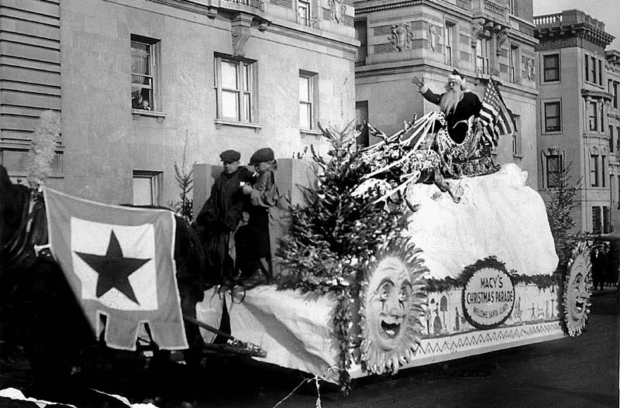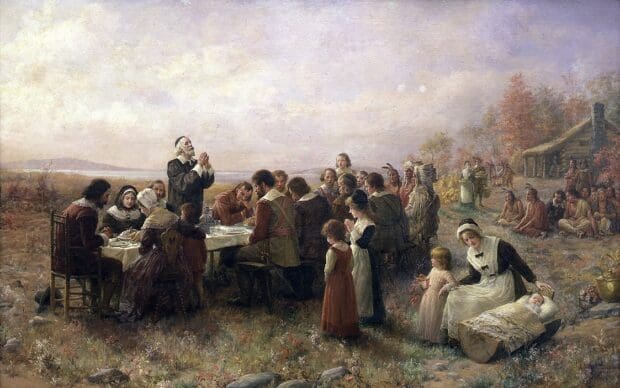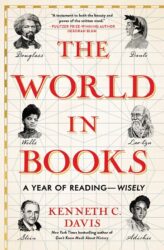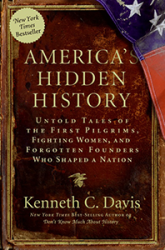As the fourth Thursday in November approaches, our country is gearing up for a diet-busting meal to celebrate those somber folks in clunky shoes and buckled hats who sailed to the New World aboard the Mayflower. The Pilgrims wore black clothing, right? And ate turkey with the Native Americans, remember? And their peaceful relations with the Indians was long lasting, correct?
Well, not exactly. But first the parade.
•When did Macy’s start its iconic parade?
The Macy’s tradition began in 1924 (Philadelphia’s is older) and started as a “Christmas parade” –stepping off in Harlem and ending at Herald Square with Santa Claus enthroned as “King of the Kiddies.” (New York Times)

Santa’s Sleigh 1924 Macy’s Christmas Parade https://en.wikipedia.org/wiki/File:Santa%27s_Sleigh_(1924).webp
Macy’s employees were the marchers –there were floats but no balloons yet—and many of them were recent European immigrants. The idea of a grand parade was an old European tradition. This underscores the notion that Thanksgiving is a holiday of immigrants. And over the years, many cultures and nationalities have contributed to the evolution of Thanksgiving.
The parade has only been interrupted three times –all during World War II (in 1943, 1943, and 1944) due to rationing and shortages.
If you say religious freedom, you get only partial credit. The Pilgrims were an offshoot sect of Puritans, people who were challenging the Church of England and the English monarchy itself. But the Pilgrims went another step—they wanted to separate from the Church of England completely. These Separatists left England to take refuge in Holland. Unhappy there, they set up a company that would start a new colony in America where the Virginia colony had been established in 1606.
The Mayflower Pilgrims did not call themselves “pilgrims.” They referred to themselves as “saints” or “First Comers.” Only later did William Bradford call them Pilgrims. But not even all of the passengers on the Mayflower were Pilgrims. Of 102 people on board, only about 50 were Pilgrims. The others were members of the Church of England who had signed on simply as laborers, soldiers or those looking to gain property in the “New World.” The Pilgrims called them “Strangers.”

“The First Thanksgiving at Plymouth” (1914) By Jennie A. Brownscombe (Public Domain, Source Wikimedia)
Before the Mayflower landed, it became clear that the Saints and the Strangers didn’t see eye to eye. To preserve order in the colony, the men aboard the ship agreed to a rudimentary system of democracy under the so-called Mayflower Compact; it was, in essence, the first written Constitution in American history. (Sorry ladies, only adult males could vote.)
IN THE NAME OF GOD, AMEN. We, whose names are underwritten, the Loyal Subjects of our dread Sovereign Lord King James, by the Grace of God, of Great Britain, France, and Ireland, King, Defender of the Faith, &c. Having undertaken for the Glory of God, and Advancement of the Christian Faith, and the Honour of our King and Country, a Voyage to plant the first Colony in the northern Parts of Virginia; Do by these Presents, solemnly and mutually, in the Presence of God and one another, covenant and combine ourselves together into a civil Body Politick, for our better Ordering and Preservation, and Furtherance of the Ends aforesaid: And by Virtue hereof do enact, constitute, and frame, such just and equal Laws, Ordinances, Acts, Constitutions, and Officers, from time to time, as shall be thought most meet and convenient for the general Good of the Colony; unto which we promise all due Submission and Obedience. IN WITNESS whereof we have hereunto subscribed our names at Cape-Cod the eleventh of November, in the Reign of our Sovereign Lord King James, of England, France, and Ireland, the eighteenth, and of Scotland the fifty-fourth, Anno Domini; 1620.
[The Mayflower Compact: Complete text and signers Source: Yale Law School Avalon Project
One child named Oceanus was born during the voyage. Another named Peregrine was born on board after the Mayflower landed. And one in six Americans can still claim a relative who came aboard the Mayflower. Among them are Presidents John Adams and John Quincy Adams, Zachary Taylor, Ulysses S. Grant, James Garfield, Franklin D. Roosevelt, and both Bushes.
One piece of the Pilgrim story is that two different indigenous men came to the Pilgrim camp and spoke English. The first was Samoset. He returned a few days later with Squanto (probably a shortened version of Tisquantum). Squanto had been taken captive by an English sea captain, sold into slavery in Spain, and later made his way to London where he learned to speak English. His value as an interpreter was recognized and he returned to Massachusetts on an English ship only to discover his entire village had been wiped out—probably by disease introduced by Europeans. That village was the future site of Plymouth and he indeed helped the English settlers survive their difficult first year.
Nothing, literally. To the Pilgrims, a true day of thanksgiving simply meant a day of prayer and fasting –not what most of us have in mind when turkey day comes around.
What we now call “Thanksgiving” was in fact a harvest festival for the Pilgrims who celebrated in October –not November—1621. Those Pilgrims were mostly grateful just to be alive –half of their company had died during the bleak first winter in Massachusetts after they had landed at Plymouth in December 1620. (And by the way, there was no mention of Plymouth Rock at the time. That’s clearly a notion cooked up more than a hundred year later.)
Yes, sort of. There was turkey, but not the one we know and love. It was wild turkey (the animal, not the beverage). The menu for this major feast was a colonial era surf-and-turf which included ducks, geese, cod, salmon, lobster, mussels, eels and clams, along with wild onions to make sallet (salad) and vegetables, including pumpkins (but no pie) and “crane berries” (but no cranberry jelly). Dessert would have been cornmeal breads and puddings.
In addition to about fifty Pilgrims, unexpected company arrived. About ninety Wampanoag warriors showed up with their chief Massasoit. The Indians went out like good guests and brought back plenty of venison, which was added to the menu. The harvest feast then lasted three days.
The peace and good will of that celebration lasted about a generation. First, the English settlers fought a brutal war against the nearby Pequot, wiping them out in 1637. Then, in 1676, Massasoit’s son Metacom – known as King Philip—led the Wampanoag in a war of survival against the English. (“King Philip’s War”). This bloody conflict nearly wiped out the colonists who ultimately prevailed. Metacom’s head was placed on a pole; his wife and son – grandson of the chief who came to dinner in 1621—were sold into slavery. The Wampanoag and other native nation were decimated.
During that war, a settler named Mary Rowlandson was taken captive and spent three months traversing the Massachusetts wilderness with Metacom. She later wrote an account of her captivity, The Sovereignty and Goodness of God (1682), which has been described as the first bestselling book by a woman in America. (Rowlandson’s book is among the 52 works in my new book, The World in Books.)

#image_title
• What is the difference between a Pilgrim and a Puritan?
The Puritans wanted to “purify” the Church of England –that is to get rid of any vestige of Roman Catholicism. This was not a polite religious argument over how to say your prayers, but a phase of the Protestant Reformation that eventually led to a bloody English Civil War and the beheading of King Charles I in 1649.
The Pilgrims were more radical and wanted to separate from the Church of England which is why they were banished.
While the Pilgrims arrived first, they were soon followed by a mass wave of Puritan emigration during the 1620s, and the Pilgrims were eventually absorbed into the Puritan-dominated Massachusetts Bay Colony.
Thanksgiving was first celebrated as an official holiday in 1777, to mark the patriot victory at Saratoga in the Revolutionary War. When Washington later tried to proclaim a Thanksgiving Day, some in Congress complained that he had no right to make such a proclamation.
Gradually Presidents routinely proclaimed days of “thanksgiving,” but the custom died out in the 19th century. In 1837, a writer and magazine editor named Sarah Josepha Hale began a campaign to reinstate the holiday. Hale was also the author of the poem, “Mary Had a Little Lamb.”
At Hale’s persistent urging, Abraham Lincoln finally proclaimed a national holiday of Thanksgiving in October 1863, to be marked in November.
It has seemed to me fit and proper that they should be solemnly, reverently and gratefully acknowledged as with one heart and one voice by the whole American People. I do therefore invite my fellow citizens in every part of the United States, and also those who are at sea and those who are sojourning in foreign lands, to set apart and observe the last Thursday of November next, as a day of Thanksgiving and Praise to our beneficent Father who dwelleth in the Heavens. And I recommend to them that while offering up the ascriptions justly due to Him for such singular deliverances and blessings, they do also, with humble penitence for our national perverseness and disobedience, commend to His tender care all those who have become widows, orphans, mourners or sufferers in the lamentable civil strife in which we are unavoidably engaged, and fervently implore the interposition of the Almighty Hand to heal the wounds of the nation and to restore it as soon as may be consistent with the Divine purposes to the full enjoyment of peace, harmony, tranquillity and Union.
[Abraham Lincoln’s Proclamation of Thanksgiving, Source: American Battlefield Trust]
• What happened on Thanksgiving 1864?
Lincoln issued a second proclamation the following year while General Grant’s army was besieging Petersburg, Virginia.
“Around the same time, the heads of Union League clubs – Theodore Roosevelt’s father among them – led an effort to provide a proper Thanksgiving meal, including turkey and mince pies, for Union troops. As the Civil War raged on, four steamers sailed out of New York laden with 400,000 pounds of ham, canned peaches, apples and cakes – and turkeys with all the trimmings. They arrived at Ulysses S. Grant’s headquarters in City Point, Va., then one of the busiest ports in the world, to deliver dinner to the Union’s “gallant soldiers and sailors.” This Thanksgiving delivery was an unprecedented effort – a huge fund-raising and food-collection drive. One soldier said, ‘It isn’t the turkey, but the idea we care for.’”
[“How the Civil War Created Thanksgiving” New York Times “Disunion” blog]
• What is “Franksgiving?”
During the Great Depression, Franklin D. Roosevelt moved the date to the third Thursday in November at the request of retailers who wanted to extend the holiday shopping season. Republicans balked at this break with tradition and there were two Thanksgivings that year. In 1941, with individual state governors declaring separate thanksgiving days, Congress declared a national holiday and it was fixed on the fourth Thursday in November, where it remains.
• What made Football and Thanksgiving an American tradition?
The tradition of college football dated to 1876 when Yale and Princeton played. It was transferred to the pros when the NFL formed. The Detroit Lions played a game in 1934 that was televised nationally, establishing the NFL tradition of Thanksgiving games in Detroit. The Dallas Cowboys were later awarded a second Thanksgiving Day game.
•Were the Mayflower’s passengers the first “Pilgrims” in America?
The Spanish in the Caribbean, Mexico, the American southeast, Central and South America all got to America before the Pilgrims. So did the Jamestown colonists in 1607 in Virginia. Remember 1619. And they all probably had harvest feasts before the Pilgrims too. But the true first Pilgrims in American were a group of French colonists who landed in Florida in 1654, Huguenots, or French Protestants, they came to American for the same reason the Pilgrims would more than fifty years later –to escape persecution in Catholic France.
Settling near modern day Jacksonville, they built Fort Carolina. One year later in 1655, a Spanish fleet arrived and established St. Augustine. Their purpose was simple –to eliminate the French “heretics” in Spanish Florida. In a series of massacres, hundreds of French Protestants were put to the sword by the Spanish—ending America’s first “pilgrim” experiment in a sectarian bloodbath.
Read more about this episode in America’s Hidden History.
